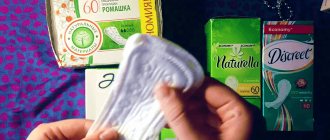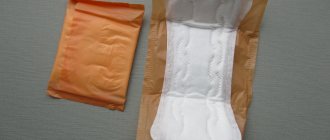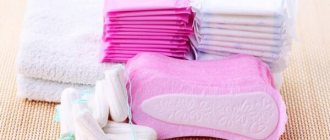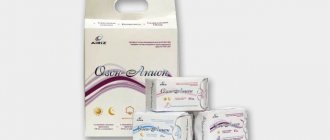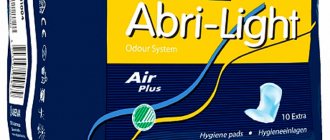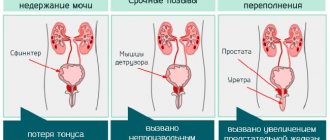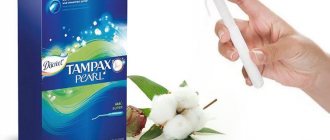Panty liners are a lifesaver for a girl who, due to circumstances, cannot otherwise take care of intimate hygiene. What are panty liners for? How to choose the “right” ones and how often to change the selected ones? What do you need to know about gaskets so as not to harm your health? You will find answers to these and similar questions below.
The daily bag serves to “collect and neutralize” natural secretions. The purpose of use is to keep underwear clean.
Every girl (woman) has physiological, absolutely normal secretion from the vagina. The intensity and composition of discharge normally depends on:
- Individual characteristics of the body
- Period of the monthly cycle
- Lady's health conditions
A girl’s “usual” motivation for using daily routines is to maintain confidence in her own cleanliness during the working (or school) day, during periods outside the home.
How did you manage without gaskets before?
For many centuries, representatives of the fair sex were forced to use improvised means as devices for collecting menstrual blood: moss, wool, fabric or cotton wool. Now there is no reliable information about who invented and patented the first gaskets.
The appearance of disposable products for women is associated with the First World War, when cellulose bandages began to be used as dressing materials, absorbing several times more blood than their cotton counterparts.
In the early 20s of the 20th century, a revolution took place in the world of fashion, one of the results of which was the appearance of closed, tight-fitting underwear. This led to the beginning of mass production of feminine hygiene products and a change in their design: the products became more compact and thin, and were attached to panties with pins or rubber straps.
Only 50 years later, prototypes of modern disposable pads were developed, which had an additional absorbent layer and a self-adhesive surface. Over the past decades, hygiene products have improved significantly, becoming more convenient, practical and affordable.
Types of gaskets
On pharmacy shelves you can find several types of disposable feminine hygiene products.
1. Pads for absorbing menstrual flow. All manufactured products differ in three main parameters:
- The volume of absorbed liquid in accordance with the “drop” gradation (a product marked “one drop” absorbs approximately 5 ml of blood, “six drops” - about 30 ml).
- Type of surface (“soft” made of soft non-woven material or “draynet” - perforated polymer film).
- Design features (presence of “wings”, absorbent grooves, extensions).
2. Panty liners designed to absorb scanty secretions.
3.Products with special functions:
- postpartum, used to absorb lochia for several days after the baby is born;
- urological, used for urinary incontinence;
- medicinal, containing special components for the treatment and prevention of certain diseases of the female genital area;
- test systems for detecting leakage of amniotic fluid, etc.
The difference between panty liners and regular pads
Since daily diapers are not designed to absorb large volumes of secretions, they have some differences from classic hygiene products used during menstruation.
| Characteristic | Panty liners | Products for critical days |
| Length | 10-15 cm | 17-25 cm |
| Thickness | 2-4 mm | 0.8-2 mm |
| Volume of liquid absorbed | 2-3 ml | Up to 30 ml or more |
| Presence of wings | No | Not really |
| Presence of gelling components | No | Not really |
| The presence of extensions, absorbent grooves and other design elements for better absorption | No | Not really |
| Surface type | "Soft" | "Soft" or "dranet" |
| The presence of an additional impermeable layer that prevents liquid leakage | No | Yes |
Despite significant differences, products for every day and for absorbing menstrual flow have almost the same layer-by-layer design. The main absorbent material in both cases is cellulose.
Why do you need panty liners?
The main function of daily hygiene products is to keep underwear clean and fresh throughout the day. They can be used in the following cases:
- for insurance before the onset of menstruation;
- to absorb residual spotting during menstruation, at the final stage of lochia or after surgery;
- for additional protection when using tampons;
- with heavy discharge, with the exception of menstruation (during ovulation, use of certain medications);
- to maintain cleanliness in the absence of the possibility of timely intimate hygiene (on the road, etc.).
What are the daily routines?
All manufactured products for daily use differ in two main parameters.
Form . Most panty liners have a straight or anatomical design (tapered in the middle). Recently, improved hygiene products have appeared on pharmacy shelves:
- V-shaped for tanga or thong panties;
- shortened, covering only the gusset of the underwear;
- with a front opening for panties made of translucent fabric or lace.
Additional functions:
- with or without flavoring;
- white or black depending on the color of the linen;
- with increased absorbency due to the improved composition of the top layer;
- with perforation for additional air exchange.
Feminine hygiene products for every day are produced by the same manufacturers as products for critical days. According to sociological surveys, the rating of panty liners is as follows:
- "Naturella Light" (the most breathable).
- "Descreet Normal" (best absorption capacity).
- "Ola!" (affordable price).
- "Kotex" (convenient packaging).
Main Differences
Sooner or later, a teenage girl will be interested in the question of why girls need sanitary pads, how to choose them, and what is the difference between them. They are needed to absorb natural secretions, protect laundry from leaks and unpleasant odors. The most popular are:
Feminine hygiene. They can be found in every store. They differ in the quality of materials, degree of absorbency, the presence of various parts, wings, odor neutralizer and much more. The most popular manufacturer brands include Always, Bella, Kotex, and domestic brands include Ola, Natalie and others. One package is designed for 5-8 days, it contains from 7 to 10 pieces.
- On every day. They need to be used so that there is no leucorrhoea left on the underwear, which may appear in girls after the onset of their first menstruation. Daily supplements are needed every day between menstruation. They have low absorbency and are sold in volumes from 20 to 40 or more pieces in one package. They are produced by the same brands as feminine hygiene products. But you can decide about panty liners, which one is better to choose, only based on your needs.
- Urological. They are used by women suffering from urinary incontinence and other diseases.
- Postpartum. They are sold in pharmacies and specialty stores; they are intended to absorb discharge after childbirth. The most popular are Hartmann Samu. They can be purchased at maternity stores or pharmacies.
Flaws
With constant use, untimely change (less than every 4 hours) and non-compliance with the basic rules of intimate hygiene, daily pads can cause the development of certain pathological conditions:
- Disturbance of natural microflora . When wearing pads with a continuous adhesive layer for a long time, especially in combination with underwear and clothing made from synthetic fabrics, a greenhouse effect occurs. This provokes increased activity of opportunistic flora and leads to exacerbation of candidiasis, vaginitis and other pathologies.
- Infections . Under the influence of high humidity and temperature, dangerous bacteria rapidly multiply on the surface of the gasket, which can cause many diseases. Women who have already been diagnosed with infectious and inflammatory pathologies of the genital tract should use the daily with special caution, as this not only complicates their treatment, but also contributes to the development of complications and relapses.
- Allergic reactions (rash, itching, irritation, redness and swelling of the skin and mucous membranes). Most often, various fragrances, deodorizing substances and other synthetic components with which the surface of the product is impregnated lead to the development of allergies. In some cases, there is increased sensitivity to the adhesive or non-woven materials of any of the layers of the hygiene product.
Menstruation period
All currently existing pads that are intended for menstruation have an identical structure. They contain the following components:
- The outer layer that comes into contact with the skin. It allows secretions to pass inside easily. It is made from cotton or artificial material. In the first case, there is no irritation, but the surface sometimes remains wet for a long time. Synthetic varieties are always dry, but not as pleasant to the skin as the previous option.
- The inner layer absorbs moisture. It is made from cellulose or artificial filler. In the first case, the material causes less irritation, but the product with such an inner layer is quite bulky. Artificial granules quickly absorb liquid and turn it into a gel. But it can be irritating.
- The bottom layer is made of polyethylene or non-woven material that does not allow moisture to pass through. The latter option “breathes”, so its use is more comfortable.
This structure shows the similarity of pads that are used during monthly bleeding. But when buying, you should pay attention to a number of factors. The main thing is the absorption coefficient.
Ability to absorb moisture
To choose the optimal type of hygiene product, you need to pay attention to their absorbency. All existing varieties most often have the same classification. They are divided into the following types:
- Super plus.
- Super.
- Normal.
The scale is indicated on the packaging in the form of drops. Their number can be up to 7. The more there are, the greater the volume the product can absorb. For the first heavy days, you should purchase a product with 5–7 drops. For medium discharge, pads containing 3–4 drops are used. For the last days of menstruation, products containing 2 drops are suitable.
Today, many manufacturers produce night pads. They are longer, so they absorb more secretions.
Terms of use
Having chosen the right personal hygiene product, you need to familiarize yourself with the technique of using it. Some women, in pursuit of savings, believe that the pad should be changed as it fills. However, this is a serious misconception. Gynecologists insist that such hygiene products should be changed after 2–5 hours. This is due to some reasons:
- When menstrual fluid comes into contact with air, an unpleasant odor appears.
- Microorganisms have the opportunity to reproduce in such an environment. The cervix is slightly open during menstruation. The infection can get inside.
You should also change pads with clean hands after showering. If it is not possible to wash yourself thoroughly, you need to use wet wipes.
Terms of use
To avoid negative consequences, experts recommend adhering to the following rules:
- Use panty liners only as needed and no more than once a week;
- Change products every 3-4 hours;
- When wearing daily bags, be especially careful about intimate hygiene;
- Choose pads without fragrances with high air permeability (with perforations or a non-continuous adhesive layer applied in the form of dots or stripes).
Gynecologists advise buying products in individual packages. This is more hygienic and allows you to easily dispose of used pads.
What to answer to a child?
When a baby sees an advertisement for feminine pads on TV, it is not surprising that he will be interested in what women need pads for. To prevent your child from plastering your apartment with your diaries, thinking that they are stickers, you should tell the truth, but without unnecessary details.
You can explain to children that pads are diapers for adult women. Mothers need them once a month to absorb blood, which means that the mother is healthy and still able to give birth to children. It is better to give truthful information, otherwise the child will still find the answer in other places, and it is unknown what information he will receive.
What can be used instead of gaskets
Many girls are interested in the question of what to do if they suddenly run out of pads and there is no pharmacy nearby. To absorb a small amount of secretions, you can use the following means:
- sterile gauze folded in several layers;
- soft fabric well ironed;
- fragrance-free toilet paper.
To protect against accidental leakage, you can put a piece of polyethylene or cling film between the homemade pad and underwear.
Read
Also:
- What vitamins are needed to strengthen hair: reviews
- How to choose pads for a teenage girl?
- How to choose and wear pads correctly?
- Gaskets with anion chip: are they needed and how do they work?
- TOP 7: Choosing pads for armpits against sweat, reviews. Instructions on how to make it yourself
- Carefree pads - daily and for critical days
How to use it correctly
To avoid causing any discomfort when using hygiene products, you need to know how to use sanitary pads. In this case, it is necessary to take into account not only the place of fixation of the hygiene product, but also the location of its absorbent side, and the fastening of additional elements - wings.
How to glue it correctly
So that the use of the product for critical days is not associated with discomfort in the girl, this hygiene product should be properly attached. How to put on a pad correctly:
- before putting on hygiene products, wash hands thoroughly with soap;
- intimate places are cleaned with a napkin or water;
- the packaging is opened, the sticky side of the accessory is separated from the protective tape and put on the inside of the underwear so that the center of the product coincides with the thickening on the panties;
- The accessory is carefully pressed against the fabric to eliminate the risk of peeling off.
Most often, women use pads with wings. To put them on correctly, you need to use the previous instructions, and then perform one more step: you need to remove the protective strips from the additional fastening elements, and then attach their sticky edge to the opposite side of the panties.
